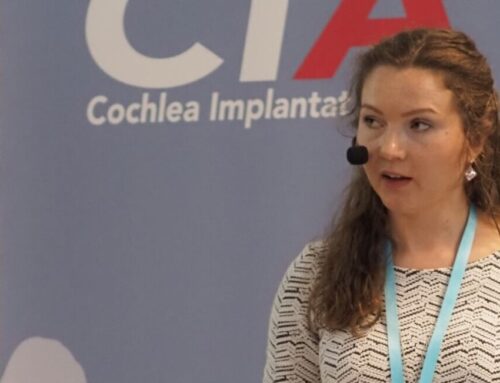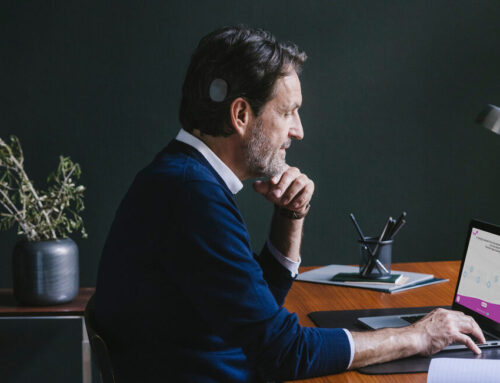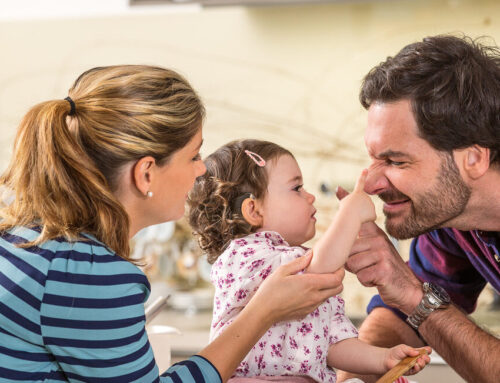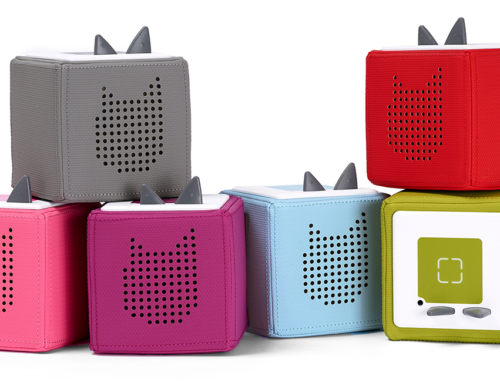Hearing training with tiptoi® for one-sided deaf children with cochlear implants
Modern streaming technologies for cochlear implants make hearing training with just one implanted ear possible. The team at St. Pölten University Hospital shows how children can also practice at home with audio toys successfully.

Cochlear implants (CI) are a proven solution for restoring hearing. They also work for people with single-sided deafness (SSD). Those affected benefit considerably from the CI in terms of speech perception, especially in complex listening environments. However, the hearing must be trained after the implantation without the normally hearing ear involved in the training.
CI users can directly control an audio processor by connecting the audio source via cable or streaming to the audio processor. They can also use this for hearing rehabilitation. The auditory stimuli are then transmitted directly to the implanted ear and external sources of interference are blocked out. This option has proven to be successful for adults, but children often find it difficult to find suitable audio sources.
The CI team at the University Hospital in St.Pölten uses the tiptoi® audio pen for children. Recently, the clinicians have published their first experience with children aged five to twelve. With tiptoi®, children usually practise every day. After just one month of regular practice, significant improvement can be noticed in speech comprehension.
Gamification in hearing training

Music therapist Bianca Wirthner, MSc from the CI team in St. Pölten has had good experiences with tiptoi® and the MED-EL streaming device AudioLink ©Julia Trinkl
With appropriate instructions from speech therapists and early intervention, parents of children with CI on both sides can integrate regular listening exercises into play and everyday life at home. This is more difficult for one-sided deaf children, as the hearing ear would have to be closed manually or with the help of an earplug during the training. However, children are usually unwilling to accept this. In addition, ear “plugging” can cause errors if the earplug is not soundproof. Unilaterally deaf adult CI users usually use various streaming options for hearing training with current audio processors. But this practice situation is far away from children´s everyday life.
On the other hand, therapists like to use special computer programs for auditory training with children. This is fun for children, it motivates them and supports the learning process. Ultimately, even a little bit of extra practice can improve hearing. With this in mind, the CI team in St. Pölten uses age-appropriate, digital audio toys. Since many children are already familiar with such toys from home, daily practice is also easier to implement.
Digital audio toys are multifunctional
The tiptoi® audio pen is a widely used toy in Austrian nurseries. This is an audio player with an infrared sensor that can read an optical identification code printed on paper. In addition to the tiptoi® pen, children need one of the e.g. tiptoi® books. By tapping the tip of the pen on a cat's picture in the book, you can hear it meow.
The sound quality of the integrated speakers is limited, but headphones can be connected via a conventional audio socket or a streaming device such as AudioLink. This is also the main difference between the game and the listening exercise – the use of streaming accessories to specifically train the CI ear. Families receiving care at the St. Pölten clinic are also provided with an inexpensive audio splitter, with one output for the AudioLink and one for headphones. This allows parents to accompany their child's interactive reading experience.
Children can play and solve puzzles and riddles with tiptoi®. There is also a tiptoi® globe. The pen can also be used as a playback device for audio books or songs. Parents can download the audio files to the pen online. The tiptoi® pen is also available with a recording function for a small extra charge. Many museums even use tiptoi® technology for their self-guided children's tours.
The choice of audio pens

Speech therapist Philipp Schörg, BSc, MSc from the St. Pölten team and part of the study team. ©UK St. Pölten
While Tonie has established itself among the audio boxes, there is a larger selection of audio pens - some of which disappear from the market after a short period. Apart from tiptoi®, BOOKii and Tellimero have also been around for some time. There are also special books for them, but thanks to the recording function and audio stickers, conventional books can also be turned into audio toys. One special audio pen is Franklin Anybook Reader, for which no special books are required. Anybook, which also comes with a recording function and audio stickers, was designed as a learning aid for elementary school and speech therapy, but it is much more expensive than the others. And it always requires the respective book to be prepared in an Anybook version.
For hearing training of the implanted ear, the hearing pen or audio box must be connected to the respective audio processor directly or via streaming accessories. This way, the implanted ear can be addressed directly, and the background noise can be blocked out. For instance, the BOOKii hearing pen is not suitable for hearing training because it does not have an audio socket.
The CI team in St. Pölten has good experience with tiptoi® and the MED-EL AudioLink streaming device. "Tiptoi® materials are usually already familiar to our CI children," explains music therapist Bianca Wirthner, MSc. She and speech therapist Philipp Schörg, BSc, MSc were part of the study team. "The handling is already clear to them. The systems are easy to use and offer a wide range of exercise options."
Manufacturer Ravensburger designed the system for children aged two to ten. In the study, the participating children were allowed to choose a tiptoi® book. "The parents of our CI children are very committed and pay attention to their children's motivation to learn," says the music therapist. The parents could also change the books during the study period if needed. "However, the exercises were carefully selected by us," adds Schörg. "On the one hand, material on the topic of sound recognition, e.g. sounds on the farm. On the other hand, exercises on language comprehension: first individual words, then whole sentence comprehension." There is currently no specific exercise material for auditory training in tiptoi®.
"The challenge for people with SSD is to integrate natural hearing in one ear and electronic hearing in the other."
Surgeon Priv.-Doz. Dr. Astrid Magele, MBA
Digital toys for hearing therapy
According to speech therapist Schörg, if a family wants to use an audio pen or audio box for auditory training, they have to pay attention to the good audio quality of the technology and the book material. Also, the content should be “suitable for a child´s current environment”. Both experts see the option of recording your own listening exercises as very positive. "This offers an opportunity to respond even more individually to the needs of each child. Nursery rhymes are particularly suitable for this, as well as stories from the environment in which the names of friends or relatives are included. Depending on the age of the children, simple fairy tales and stories could also be included."
Still, even if a child uses their audio toy often, the short practice sequences cannot replace professionally supervised early support or speech therapy! The special binaural functions, such as locating the sound source and understanding multiple speakers in a noisy environment, cannot be trained with audio pen or audio box exercises and should be trained additionally. Nevertheless, the study authors are certain that practicing with an audio pen is beneficial: "If children's toys are used, the training can be integrated into everyday life and no additional time is required for the training. The practice is, therefore, more consistent and the result will be better."
Early implantation helps - even with SSD

Priv.-Doz. Dr. Astrid Magele, MBA is a senior physician at the ENT University Clinic St. Pölten. ©private
"In cases of inherited bilateral deafness, we recommend CI implantation as early as possible. Scientific data shows that cochlear implantation around the tenth to twelfth month of life creates the ideal conditions for achieving the best possible understanding of speech," explains Priv.-Doz. Dr. Astrid Magele, MBA, Senior Physician at the ENT University Clinic St. Pölten.
Single-sided deafness (SSD) is the term used by experts to describe severe to profound hearing loss in one ear in combination to normal hearing in the other ear. The experienced CI surgeon explains this further: "although these children develop speech normally, the single-sided deafness makes it difficult for them to understand speech in noisy and more complex listening environments and with different voices. In addition, the ability to localize a sound or speech source and concentration are impaired. We therefore recommend cochlear implantation before the child starts school."
In the past, SSD intervention was limited to the transmission of signals from the deaf ear to the hearing ear. This was done either by using conventional hearing aids in a so-called CROS fitting or by using bone conduction technology. However, this means that the advantages of binaural hearing are essentially lost. In 2003, the first CI implantation for SSD was carried out as part of a study in Belgium. The team at St. Pölten University Hospital also has experience with this: "We implanted the first unilaterally deaf child in 2013. He was five years old at the time." Today, cochlear implantation is a routine procedure for unilaterally deaf patients of all ages in Austria, as well as in many other countries.
Doz. Magele adds: "The challenge for people with SSD is to combine natural hearing in one ear and electronic hearing in the other." Thus, experts recommend practicing the new hearing with CI without involving the healthy ear in the exercises. On the other hand, those affected should train their binaural skills, e.g. directional hearing and hearing in noisy environments, together with the CI ear and the other, hearing side.






